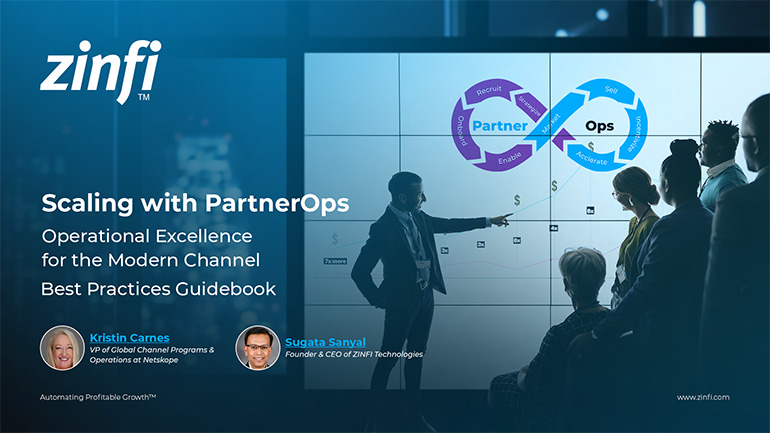Best Practices Articles

Helping Channel Partners Co-brand Sales Assets Using Your PRM Tool
Partner relationship management (PRM) tools have existed for more than a decade right now. Although early in the 2000s there were a few companies trying to build applications to manage a distributor channel, the actual proliferation of PRM software didn’t really happen until about five years ago. The primary focus for PRM tools is automating workflows between a vendor and a partner to make it easy to do business. Most PRM platforms come with a whole bunch of application modules ranging from onboarding, contracts and learning management to asset sharing, deal registration, incentives and more. In this article we will explore the concept of co-branded assets and how co-branding can help vendors streamline distributed sales activities as well as increase sales.
You may be wondering what exactly asset co-branding is. Let me explain - Co-branding allows your channel partner to put their logo next to your logo on specified assets and share those assets with the end-customer. This allows the partner to claim a formal association with your brand and gives them an opportunity to ride on the halo of your logos. However, vendors who enable co-branding need to make sure their brand and logos are protected and don’t get distorted— whether intentionally or not—when assets are shared. It’s critical for vendors to maintain control over their branding and be able to enforce co-branding guidelines.
Vendors recruit channel partners for one primary reason: to sell the vendor’s products and services. For the relationship to work, the vendor needs to help the partner learn to sell the vendor’s product and services. In order to succeed in that mission, sales reps from the partner organization need to have access to a set of sales tools and sales materials or “slicks.” Traditionally, the vendor provides these through their partner portal, assuming they have one. However, in most companies where the channel organization is in its early stages of formation and doesn’t have a PRM tool, the channel team ends up sharing these documents via Dropbox or other file-sharing tools. This makes the experience pretty cumbersome, because the partner has to go through a flat file structure to figure out what’s what. Also, this reliance on file-sharing sites makes it easy for partners to make mistakes when they select an asset, co-brand it and share it with their end-customers.
This is exactly where a co-branded asset module or application becomes very useful. Most PRM tools or platforms today include some sort of a co-branding capability. If you’re evaluating a PRM tool with co-branded asset capabilities, make sure the core features are capable of addressing your needs as well as your partners’ needs. You should consider:
- Types of assets: When you’re evaluating a PRM tool, make its co-branding capabilities are world class and can accommodate multiple types of assets, such HTML, HTML5, PDFs and other common document types.
- Asset preview: Your partners should not only be able to co-brand assets with different types of logos and insignias but should also be able to preview assets easily before they download them for offline use. They should also be able to share these documents, if required, directly from the system.
- Co-branding of assets: Co-branding should be easy. Partners should be able to select a set of assets you have provided to them and quickly add customized content in specified areas, based on their edit and access rights. You should be able to configure access and editing rights so, for example, your Gold partners are allowed to modify more areas than your Approved partners and add their own content.
- Print quality: Assuming your partners send out printed materials to their customers, you will need the ability to provide high-resolution print quality assets to your partners for their co-branding activities. Unlike ZINFI, most PRM vendors in the market today are not able to do that.
- Analytics: Finally, it’s essential that your PRM tool is capable of providing deep analytics so you can figure out which partners are accessing which materials, and what changes you need to make to improve partner adoption and sales throughout your network.
In addition to the features that I discussed above you may also require approval routing functionality. While we don’t see this as a common feature request from many existing customers, we do sometimes see it from larger accounts where there is a need to control their brand in a clear way. With approval routing, partners will need to ask for approval from a channel marketing manager on the vendor side before any modifications can be finalized. This workflow management capability is pretty critical for some vendors, especially if they are sending materials overseas and don’t have a local agency that can manage this for them.
The ability of partners to easily co-brand your assets and share them with their customers is a core sales requirement in today’s world, where most transactions are happening online rather than face-to-face. When you are evaluating PRM tools, there are a lot of choices out there. It’s easy for vendors to present a slick demo to showcase some of their capabilities, but these days I don’t recommend buying software unless you can try it on your own to make sure the product actually does what the salesperson says it can. I would strongly urge you to ask prospective PRM vendors to give you a free trial so that you can test drive the solution before you buy it.
I hope this article gives you a high-level overview of how you can take your manual processes for sharing assets with your partners to the next level by using a quality PRM tool to automate the process. If you have any additional questions or want to learn more, please go to www.zinfi.com and request a free trial to test the industry’s leading, most advanced co-branded asset module in ZINFI’s world-class PRM platform.
For more information, please check this article.
Best Practices Guidebook
 Reimagine Sales Development. Build a Smarter Prospecting Engine
Reimagine Sales Development. Build a Smarter Prospecting EngineDownload Guide
 The Zero Trust Imperative: Fortifying Enterprise Security Against AI-Driven Threats
The Zero Trust Imperative: Fortifying Enterprise Security Against AI-Driven ThreatsDownload Guide
 PartnerOps Excellence: The Definitive Guide to Scalable SaaS Ecosystems
PartnerOps Excellence: The Definitive Guide to Scalable SaaS EcosystemsDownload Guide
 The Modern Partner Ecosystem Best Practices
The Modern Partner Ecosystem Best PracticesDownload Guide
 Partner Marketing Reimagined: Strategies for Agile, Insight-Led Growth
Partner Marketing Reimagined: Strategies for Agile, Insight-Led GrowthDownload Guide
 Scaling with PartnerOps Best Pratices
Scaling with PartnerOps Best PraticesDownload Guide
 Leading with Partner Programs Best Pratices
Leading with Partner Programs Best PraticesDownload Guide
 The Partner-First Blueprint: Scaling Trust, Intelligence, and Ecosystem Growth
The Partner-First Blueprint: Scaling Trust, Intelligence, and Ecosystem GrowthDownload Guide
 Unlock Scalable Growth with The Partner Marketing Growth Blueprint
Unlock Scalable Growth with The Partner Marketing Growth BlueprintDownload Guide
 From TikTok to LinkedIn: Social Selling Across the Generational Divide
From TikTok to LinkedIn: Social Selling Across the Generational DivideDownload Guide
 Scaling Partner Ecosystems: From Enablement to Intelligence
Scaling Partner Ecosystems: From Enablement to IntelligenceDownload Guide
 The Ultimate Guide to Partner Marketing Success Best Practices
The Ultimate Guide to Partner Marketing Success Best PracticesDownload Guide
 How to Start and Scale Partner Ecosystems Best Practices
How to Start and Scale Partner Ecosystems Best PracticesDownload Guide
 The Evolution of PartnerOps: Past, Present & Future Best Practices
The Evolution of PartnerOps: Past, Present & Future Best PracticesDownload Guide
 Mastering Channel Sales: Strategies, Best Practices, and Growth Tactics for 2025
Mastering Channel Sales: Strategies, Best Practices, and Growth Tactics for 2025Download Guide
 Winning with Partner Advisory Councils: Best Practices for Partner Engagement & Growth
Winning with Partner Advisory Councils: Best Practices for Partner Engagement & GrowthDownload Guide
 The Future of Partner Ecosystems Best Practices
The Future of Partner Ecosystems Best PracticesDownload Guide







